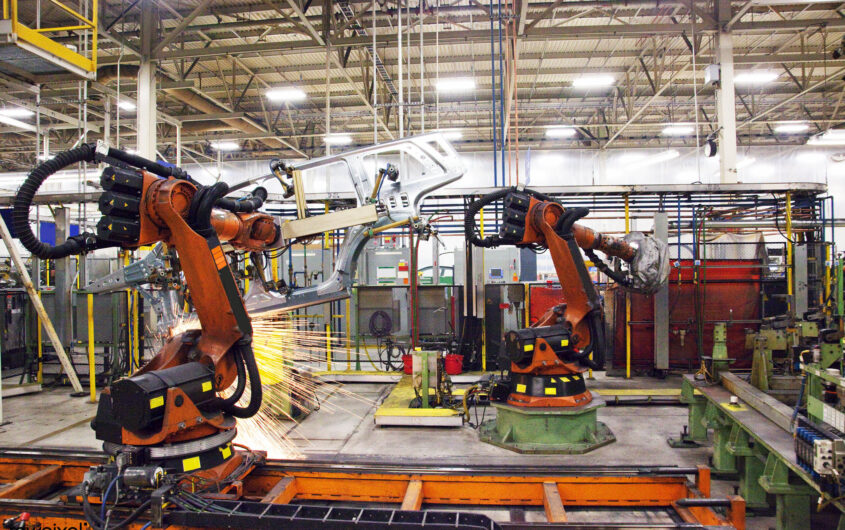
Rawpixel via Flickr
Germany Needs More Industrial Policy

Sebastian Dullien
Macroeconomic Policy Institute (IMK) and HTW Berlin – University of Applied Sciences
Sebastian Dullien is Research Director at the Macroeconomic Policy Institute (IMK) of the Hans-Böckler-Foundation in Düsseldorf, professor for International Economics at HTW Berlin – University of Applied Sciences and Non-Resident Senior Fellow at AGI. His research focuses on European integration, international macroeconomics, and financial market regulation.
He has worked as a consultant and expert for the different political foundations, different sub-organizations of the United Nations, and has testified in front of different committees of the German Bundestag and the European Parliament.
From 2000 to 2007, he has worked as a journalist for Financial Times Deutschland, the German language edition of the FT. He first worked as a leader writer and then moved to the Economics desk. From 2002 to 2007, he has been responsible for the paper’s coverage of the global, European and German business cycle as well as developments in German academic economics.
Today, he writes a monthly column in the German magazine “Capital”, regular contributions to Spiegel Online, and irregular op-eds for a number of other German media.
His book “Decent Capitalism” (joint with Hansjörg Herr and Christian Kellermann), which provides a blueprint for a better regulated are more stable capitalism after the crisis, has been published in 2011 by Pluto Press. An earlier German version (“Der gute Kapitalismus”) has been widely discussed in Germany.
The past two years have been hard for the German economy. Not only has the energy price shock following Russia’s invasion of Ukraine in February 2022 shaved off roughly 4 percent of Germany’s GDP, but it has also created deep cracks in Germany’s underlying growth model.
Since the turn of the century, Germany’s economy has grown by selling its advanced machinery and luxury cars to the rest of the world and especially to China. As China went on an investment binge, its demand for German products seemed insatiable. At the same time, Germany managed to benefit from cheap intermediary products, both from Asia and central and eastern Europe and, as a consequence, managed to keep domestic manufacturing employment as well as wages up.
Russia’s attack on Ukraine has all but destroyed this growth model. While the end of energy deliveries from the East is an important short-term factor for Germany’s current economic weakness, the main problem lies deeper.
Many commentators have lately insinuated that cheap Russian energy was a key factor to Germany’s manufacturing success. This claim does not hold up to scrutiny. Natural gas from Africa, which has mostly supplied the Iberian Peninsula and Italy, has not been significantly more expensive than gas from Russia. Moreover, natural gas in the United States has been significantly cheaper than Russian gas in Germany for more than a decade now. The more significant problem for the German growth model is the tectonic shift in geopolitics which has taken place over the past decade or so and has become impossible to ignore with Russia’s Ukraine invasion.
Large parts of the German establishment have long believed in “Wandel durch Handel,” or “change through trade.” The idea was that strong trading linkages would keep other countries from using military aggression against their neighbors as potential economic losses from interrupted trade relations would be too high. Consequently, with the benevolent consent of successive German governments, German companies expanded their trade and investment networks in China and Russia. At the EU level, Germany pushed for free trade agreements for the sake of creating a global level playing field for international trade, but with little regard for proper geostrategic considerations.
Putin’s aggression against Ukraine has clearly demonstrated that the promise of “Wandel durch Handel” has been wrong, at least in the extreme version which hoped for stable and long-lasting peace. Autocratic regimes do not necessarily follow the aim of maximizing economic welfare but might often be willing to sacrifice gains from trade for nationalistic and militaristic goals.
The energy shock that hit Germany after Russia’s Ukraine invasion has made painfully clear that the current level of trade dependencies on single countries—Russia for energy, China for semiconductors and many other products—is incompatible with the idea of a European or even German strategic autonomy. Germany has become prone to being blackmailed by countries of questionable reliability. With this level of vulnerability, Germany is scarcely able to conduct its own independent foreign policy, and risks to its prosperity from geopolitical events such as a potential military conflict over Taiwan are high.
Germany must now reinvent its economic growth model at the same time as it intends to decarbonize its economy. This is a difficult stunt, as prior plans for decarbonizing the manufacturing sector were based on affordable (even if not cheap) natural gas deliveries from Russia as a “bridge technology.” With natural gas now sustainably two to three times more expensive than before the Ukraine invasion, decarbonization—already ambitious as it was originally planned—has become much more challenging.
The more significant problem for the German growth model is the tectonic shift in geopolitics which has taken place over the past decade or so and has become impossible to ignore with Russia’s Ukraine invasion.
Some observers advocate just allowing deindustrialization to play out, letting energy-intensive industries die and the German economy find new areas of comparative advantage. In their eyes, Germany is excessively industrialized for a country of its level of economic development anyway, and the energy price shock is an opportunity to correct this imbalance. They point to the UK or the United States, which by now have a much lower share of manufacturing in value added than Germany and yet a high level of per capita income.
At closer view, however, this advice neglects important dimensions. Germany has decades of specialization in complex manufacturing processes and value chains. Even German services often are complements to its manufacturing products. Shifting to high-value-added services independent from its manufacturing core has path dependencies. With both the United States and the UK strong in financial services and the United States in IT, it is much more difficult for latecomers such as a transforming Germany to move successfully into these sectors.
Moreover, deindustrialization both in the United States as well as the UK has come with severe side effects. Without London (which arguably is very affluent thanks to the shift to high-value services), the UK on average has a lower GDP per capita than all German regions but the poorest corners of East Germany. In the United States, the loss of blue-collar jobs has contributed to political polarization and Donald Trump’s electoral successes as the work of David Autor and his coauthors has shown.
Hence, a better option for securing Germany’s prosperity into the future would seem to be to learn from other countries, and in this case specifically from the United States and France. Both countries are much more open to the use of industrial policy for pushing their own geoeconomic goals, albeit in slightly different ways. While France has a tradition of embracing active industrial policies, the United States has recently moved toward more aggressive industrial policy approaches with its Inflation Reduction Act and the CHIPS Act.
Already, a rethink of industrial policy has happened in Europe and Germany. The recent decision to subsidize Intel’s new plant in Eastern Germany and the EU’s decision to allow such state aid is a case in point. In order for Germany and Europe to decarbonize, carry their prosperity into the future, and develop a true strategic autonomy, this path needs to be followed further.
However, the challenge is to use industrial policy but not overdo it. Corporate attempts at rent-seeking are an ever-present danger when industrial policy instruments are implemented. Hence, such an approach needs to be designed as a European, not national industrial policy, both in order to reap the benefits of the single market and to keep competitive pressure high amid support for certain sectors.
Making such an approach successful requires first a strategic decision about which industries Europe needs for strategic autonomy and to keep pace with new technological developments. These industries need to be supported using clear criteria and rules. Not all existing and threatened industries can and should be rescued. Some will have to disappear in the end. On the other hand, the requirement of strategic autonomy means that not only new technologies and markets should be supported, but also a core of capabilities to reduce external vulnerabilities.
Unfortunately, industrial policy for developed countries has been under-researched over the past decades. It is thus even more important to watch and analyze carefully how different industrial policy initiatives across the world work out. The United States once again is an important point of reference here, and Germans should observe it closely.








